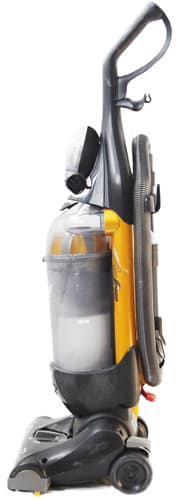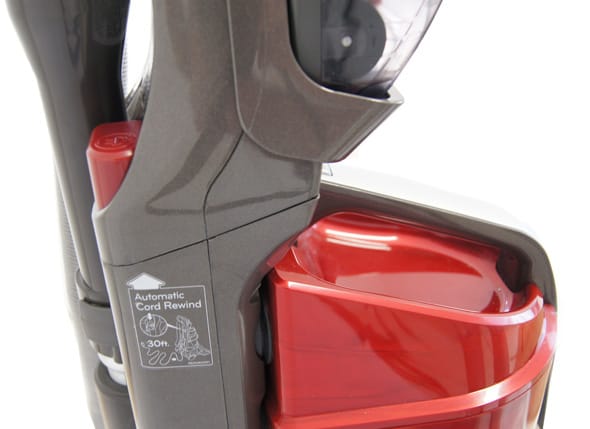Pros
Cons
Introduction
Introduction
As you might expect for $60, the Eureka ReadyForce 900A is a rather basic product, constructed from lightweight plastic. But it is pretty easy to set up and use.
Front
{{section_header}}{{section.name}}{{/section_header}}

Side
{{section_header}}{{section.name}}{{/section_header}}


Handle
{{section_header}}{{section.name}}{{/section_header}}

Controls
{{section_header}}{{section.name}}{{/section_header}}

Dirt Container
{{section_header}}{{section.name}}{{/section_header}}

Underside
{{section_header}}{{section.name}}{{/section_header}}


Overall Cleaning
The {{product.model}} is a low cost cleaner, but it is also a pretty low performing cleaner. We found that it had weak performance in all of our tests. It might be adequate for a small space with wood floors, but it would be a poor choice for anyone with carpets or a large area to clean.
Long Carpet
The performance of the {{product.model}} in our test for picking up dirt embedded in a deep pile carpet was very poor as it only managed to pick up about 13 percent of the test dirt. Unless you clean very slowly, that is going to mean dirty carpets.
Short Carpet
Performance with a short pile carpet was better, but it was still rather poor. We found that this cleaner managed to pick up just over 26 percent of the test dirt.
Wood Floor
Even the wood floor was an issue for this cleaner. We usually see figures in the high 90s for this test, but the {{product.model}} could only manage to pick up just over 71 percent of the dirt. You could improve this by cleaning more slowly or repeatedly passing over the same area, but both are going to make cleaning with this little vac a frustratingly slow exercise.
Pet Hair
It's no surprise that pet hair was a problem for this cleaner; it was unable to shift the more embedded hair in our test, because it just doesn't have the power to shift it.
Debris Pickup
The {{product.model}} had more acceptable (but definitely not good) results when we looked at how well it can pick up larger bits of debris on a carpet and wood floor. We found that with both types of flooring, it managed to get around 80 percent of the rice grains and noodles, but it struggled to pick up the coins we use in this test.
Dirt Holder Capacity
The {{product.model}} uses paper bags to hold the captured dirt, and we found that these did not hold that much dirt before they needed to be replaced. We would estimate that a bag would not typically last more than a few weeks of cleaning.
Handling
{{section_header}}{{section.name}}{{/section_header}}
The {{product.model}} is a small, compact model, which makes it easy to carry. When in use, it can be placed horizontally or vertically, and the large wheels mean that it can be easily dragged around as you clean. It is a little awkward to carry, though, with the long, curvy hose and motor dragging behind.

Cleaner Controls
{{section_header}}{{section.name}}{{/section_header}}
The controls for this cleaner are simple: from the left there is a power button, a suction control dial and a power cord rewind button. These large buttons require quite a lot of force to press, but they are also large enough that they can be easily pressed with the foot.

Cleaning Tools Use
{{section_header}}{{section.name}}{{/section_header}}
There are only two cleaning tools on this cleaner, both of which attach to the hose. The tool that is not currently in use can be stored on the side of the rigid part of the hose, below the handle.
Nozzle/Brush - The short nozzle (4 inches long) slips onto the end of the hose. It also includes a bristly brush end, which twists into place when needed to help dislodge dirt.
Floor Nozzle - The floor nozzle has a 9.5-inch wide cleaning path, and offers two settings for carpets (with brush) and hard surfaces (without brush, but with a rubber lip which helps to lift dirt from the surface). You switch between them by lifting a switch on the side. This switch is a little small to be changed with the foot, and you really need to lift up the hose end and use your fingers.

Power Cord
{{section_header}}{{section.name}}{{/section_header}}
The power cord of this cleaner is 16 feet, 6 inches long, which is rather short when other cleaners have power cables that are often about 24 feet long. Pressing the rewind button on the top of the cleaner makes the cable spool back into the body of the cleaner at a fair speed, although it does stop if it gets tangled. The rewind action also sometimes needs a hand. With shorter lengths, you often have to pull the cable to give it a start or to make sure it is fully rewound.

Hose Use
{{section_header}}{{section.name}}{{/section_header}}
This canister-style cleaner uses the hose for all cleaning, so best not vacuum up anything too large as it might get stuck.
We found that the hose could extend out to clean up to nine feet and two inches away from the cleaner, and up to 4 feet and 4 inches upwards with the extension tube on the hose. Both of these are decent, but not exceptional, numbers.
Dirt Holder
{{section_header}}{{section.name}}{{/section_header}}
The {{product.model}} uses paper bags to store the dirt in. Though it's nice to throw away dirt contained in a neat package, the bags are also pretty small. They're replaced by opening the top of the body and sliding them out. A small plastic catch holds them in place. The bag then lifts out easily enough, but you can't seal the bag, so there is a chance that some dust will escape. Replacement bags cost about $6 for a pack of 3, so that's about $2 each.
The process of fitting and replacing bags is not overly complex, and it's nice not to have to look at your dirt, but the process lacks the simplicity of a bagless model and inevitably adds costs. If you use a vacuum cleaner a lot, you might also save more in the long run by spending more on a bagless model.

Filter
{{section_header}}{{section.name}}{{/section_header}}
Two filters are on this cleaner: a prefilter that keeps large debris from damaging the motor, and an exhaust filter that filters the outgoing air. Neither of these are HEPA qualified, but they seemed to be adequate to filter out most dust in our tests. Both filters are washable and reusable.

Weight
{{section_header}}{{section.name}}{{/section_header}}
The {{product.model}} is a lightweight model, with the total weight of the cleaner and cleaning tools of just {{product.manufacturer_specs['Weight']}} pounds. That means it is small and light enough to easily carry around with you, although the non-foldable or shrinkable hose is a little awkward to carry around, and will take a lot of space in the closet even when it's hooked onto the body of the cleaner.
Noise
Most canister vacuums are quieter than their upright cousins, and the {{product.model}} is no exception: we measured the noise level while cleaning a carpet at around 70 decibels. The noise is loudest at the back, with the air rushing through the filter making a loud whooshing sound.
Energy Use
Although it is smaller than most, the {{product.model}} uses quite a lot of power: running at the maximum cleaning setting, we found that it used 980 watts of power.
Dyson DC24 Multi Floor Comparison
Both are small, compact cleaners, but the Dyson is the better designed model. It is also three times the price of the 900A, though.
These two cleaners are compact models that compromise cleaning performance for size, with both posting only mediocre results in our tests. The Dyson was the higher scoring model overall, but it is also the most expensive by a considerable margin.
The Dyson is the clear winner here again, with a better set of features and controls. The 900A offers simplicity, but it is also cheaply constructed, and changing the dust bag is awkward. By comparison, the removable dust container of the Dyson is very easy to use.
The DC24 is a little quieter, thanks to some more sophisticated engineering and a smaller motor. Both cleaners are quieter than their larger siblings.
Bissell 18Z6 Lift-Off Comparison
The Bissell is the more powerful and sophisticated cleaner by a long stretch, but the Eureka is much cheaper.
The Bissell was the stronger performer in most of our tests, thanks to its more powerful suction and larger cleaning heads. However, the Eureka managed adequate scores in many of our tests, and might be a good money saver if you are cleaning a small area.
Both cleaners have their issues, with the Eureka being a very basic cleaner, and the Bissell suffering from having too many features that are awkward to use.
The Eureka is the quieter cleaner, and it uses less power.
Hoover Platinum S3865 Comparison
The Hoover is the better cleaner by a significant margin, but it is also much more expensive.
The Eureka was outclassed by the Hoover canister cleaner in all of our tests, with the exception of our wood floor test, where both cleaners had similar performance. The Hoover is the more expensive model, but it does offer much more performance for the price.
Both cleaners are simple to use, with easily swappable tools and retracting power cables. The Hoover has a better selection of cleaning tools, though, and offers much longer cleaning range and overall flexibility.
Both cleaners produce about the same level of noise, and both are significantly quieter than their upright cousins.
Overall Verdict
{{section_header}}{{section.name}}{{/section_header}}
The {{product.model}} is a cheap cleaner, and it shows: we found adequate performance for general use, but only very basic cleaning tools and a small capacity for the dirt bags. It might be fine for small apartment or dorm room dwellers, but it doesn't have the chops to handle the typical home.
Performance
{{section_header}}{{section.name}}{{/section_header}}
The performance of the {{product.model}} is best described as adequate. It is adequate for cleaning small spaces or odd spills. It suffices if you need a vacuum to use in the garage or in a vacation house. But it won't be adequate for a larger home, or for a home with a lot of carpet, as it doesn't have the power to clean bigger areas.
Usability
{{section_header}}{{section.name}}{{/section_header}}
The {{product.model}} is a no-frills product, but it is easy to use. Frequent vaccumers may find the cost of the frequent changes of the dirt bags (at around $2 for the manufacturers own) a little galling, though.
Noise
{{section_header}}{{section.name}}{{/section_header}}
The {{product.model}} is a relatively quiet cleaner, and it doesn't draw a huge amount of electricity.
Meet the tester
Richard Baguley is a veteran writer who has written about technology ranging from Alphabet to Zip file utilities. He has contributed to pretty much every major tech publication, including Amiga Format Magazine, PC World, Wired, CNET, Toms Guide, Forbes, and many others. He lives in the Boston metro area with his wife, dog, and an indeterminate number of cats.
Checking our work.
Our team is here to help you buy the best stuff and love what you own. Our writers, editors, and experts obsess over the products we cover to make sure you're confident and satisfied. Have a different opinion about something we recommend? Email us and we'll compare notes.
Shoot us an email